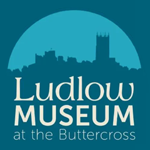DISCOVER THE LOCAL ARTIFACTS ON OUR MAP
Interactive Map
Use the map of Ludlow to explore the town’s rich history...
Castle Square
Stand at the cannon and begin your tour with a bang!
FIND OUT More
Winter 1501: Prince Arthur and his bride, Catherine of Aragon, arrive at the castle for a mere four months of married life before Arthur’s tragically early death. From this spot, imagine young Catherine’s first impressions of Ludlow...


Quality Square
In the 1590’s a brick house was de Rigueur. This one belonged to Charles Fox, leader of the Council of the Marches. See the Council’s seal in our collection.
The Rows, Harp Lane
Medieval building techniques, from wood carving and construction to ceramic floor tiles, are abundantly evident in Ludlow.
Here, on the timbers of Tamberlaine House, you can spot the carpenters marks. In the museum, we have examples of some beautiful and ‘local to Ludlow’ Medieval tiles.


College Street and St Laurence’s
The wealth of Ludlow came largely from the Guilds. The Palmers Guild built the church and a college for the priests to live in. They also funded the Guildhall in Mill Street.
The Guilds built almshouses and relied upon donations to help with the care of the poor and elderly. Just as we would use a donations box today, the Company of Stitchmen used a barrel to hold coins.
During your tour you may be lucky enough to hear the carillon (a wonderful music box cylinder on a grand scale) played from the tower of St Laurence’s. Ludlow’s carillon is one of the last remaining working carillons in the UK and dates to 1638.
The Buttercross has a fragment of an earlier carillon from the church.
Imagine while you are here: the heart of Prince Arthur lies buried in St Laurence’s, marked by a plaque in the floor of the chancel…
King Street and The Narrows
The Draper, the tailor and the glover... Ludlow was a wealthy wool and cloth town with it’s gloving trade reaching its height in the early 1800’s. Bodenhams has been the site of a ‘corner shop’ since the 15th Century.
The Company of Stitchmen's Guild of Ludlow represented the town's needle workers and cloth merchants including tailors, mercers, drapers, cappers, hatters, glovers, skinners, felt-makers, haberdashers, bodice-makers, stay-makers, mantua-makers, stationers, furriers, book-binders and book-sellers. This area of town housed many such artisans.
While you are in King Street, look for a tiled entrance bearing the name ‘Maypole’. Not a glovers’ but a grocer of renown in the early 20th Century.


The Bullring
Scene of the ‘beaste market’ and much mayhem and merrymaking, From the Bullring you can see The Bull and The Feathers. These two watering holes re-established for a while the ancient and infamous Tug-o-War that used to create total havoc in the town on Shrove Tuesday.
Broad Street
The view! From the arched window of the Buttercross see Ludlow as John Betjeman described it in 1943: ‘with it’s hill of Georgian houses ascending from the River Teme to the great tower of the cross-shaped church, rising behind a classic market Building.’ Stand and look from the Buttercross at ‘one of the loveliest views in England’.
Amongst the fashionable people who visited The Angel was Lord Horatio Nelson who was given the freedom of Ludlow in 1802.


Market Street and Assembly Rooms
Now you are back in the Market Square. Try to imagine the space filled with, and dominated by, a High Victorian Gothic Town Hall.
Demolished with some controversy in 1986, it held the town’s market, ballroom and council chamber for just short of a century. Declaration of war was made from it’s balcony, 14th August 1914… (Photo of the declaration, by WW1 display)
Detour down Mill Street: Ludlow’s Guilds
A short stroll down Mill Street will take you to The Guildhall. Now the home of Ludlow Town Council, it was rebuilt in 1411 by the powerful Palmers Guild.
The 18th Century facade we see today encases the earlier structure which includes a huge, aisled hall, once used as the town’s magistrates’ court (Shropshire’s oldest courthouse).


Detour to Whitcliffe: from the Saxons to the coral sea…
Think you’ve gone back a long time in history?
900 years is a long time...but The Museum at the Buttercross displays a dagger pommel that dates back over 1000 years to c600AD. This beautiful example of Anglo Saxon cloisonne artwork was
lost or, most likely, given to the River Teme as a votive offering, before the castle was in existence.
And how about going back 400 million years!? If you find a fossil on your wander through Whitcliffe Common, think of geologist Roderick Impey Murchison and his ground-breaking work: ‘The Silurian System’ (1839). Yes, Ludlow was once under a coral sea...
